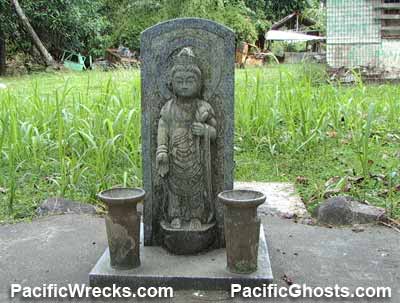|
|
|
|
| Missing In Action (MIA) | Prisoners Of War (POW) | Unexploded Ordnance (UXO) |
| Chronology | Locations | Aircraft | Ships | Submit Info | How You Can Help | Donate |
|
 USAAF 1944  Justin Taylan 2005  Justin Taylan 2005  Justin Taylan 2005 |
Location Lat 3° 25' 0S Long 143° 26' 60E Boiken is located on the north coast of New Guinea. Also known as "Boikin". To the east is the Hawain River, Banak and Wewak. The Malamba Creek runs inland from Boiken. Today located in Wewak District of East Sepik Province in Papua New Guinea. Wartime History During the middle to late December 1942, occupied by the Imperial Japanese Army (IJA). During late 1944, the Boiken area was under the command of Japanese Army Colonel Emoto. Other units included 21 Infantry Motor Battalion commanded by Major Okamoto and the 48 Road Construction Unit and a Military Police (MP) barracks commanded by Major Nakahara with WO Nakmuru. Starting in the middle of 1944, the Boiken area was targeted by Allied bombers and fighters. American missions against Boiken (Boikin) August 27, 1944–September 2, 1944 By late April 1945, the Australian Army advancing from Dagua via Cholial approached Boiken from the west. By April 28, 1945 Boiken was captured and Lt. General Vernon A. H. Sturdee (Commanding Officer, First Army) inspected the area including the 16th Infantry Brigade area as members of the 2/1 Tank Attack Regiment dug gun pits for their 75mm Pack Howitzer M1 to provide artillery support against Japanese dug into positions further inland. Afterwards, Boiken was used as a staging base for the Australian Army as they continued their advanced westward towards Wewak and remained in use until at least July 1945 or later. Japanese Barge Wreck The wreckage of a Japanese barge is on the shore at Boiken. Covered by sand, only part of the engine and fuel tank are visible today. A barge anchor is displayed in the village. Japanese Roads The Japanese built a series of limited roadways several kilometers inland from Boiken. Disused since the war, the road beds are still visible to this day and used by locals for foot traffic. Japanese TU-10 Trucks Two Isuzu TU-10 Trucks are abandoned off the old road several kilometers inland. Likely parked where they were abandoned. One is near a large pit, the other is mostly buried by sediment, likely in an earthen revetment. Japanese Navy Hospital Boiken Several kilometers inland, the Japanese had a large hospital. Buildings were constructed from bush materials, including a separate quarters for doctors, and area for patients inside to larger hillsides, and located near a river. Tetsuo Watanabe writes in Naval Land Unit that Vanished in the Jungle, page 59: "May 6, 1944 Soon we reached the Boiken Naval Garrison. The navy men there were wearing neat uniforms. In sharp contrast, we were wearing tattered and muddy uniforms [from trek by foot from Sio and Madang areas]. But it did not matter. We had arrived at our destination. It took us 18 days from Oramba [Hansa Bay area]. I suddenly began to feel my exhaustion. As the bombardment was intense, we entered deep into the jungle to camp." As death rates increased, mass burial graves for dead were dug into nearby hillsides. Since the 1950's and concentrating their efforts since the 1970s to the present, the Japanese Government's Ministry of Health and Welfare has been returning to this area, as part of 'Operation Boiken' to exhume remains and return them to Japan. Several of the burial areas have each yielded 700+ sets of remains, buried approximately 1-2m in the ground, and stacked two or three in each grave. Other burial areas have yielded several hundred. To this day, exposed remains are still found in the area. Doctor Fumuio Yana Grave Site & Memorial Japanese Army doctor, from Kobe. According to locals, this strong and handsome doctor was in charge of the Boiken Hospital and also had several Boiken villagers as assistants. He was killed during October 27, 1944 and his body was brought inland to the hospital for burial. His grave was carefully outlined with rocks to mark the spot. His daughter, a Kobe School Teacher, was able to trace her father's history to Boiken from a single letter he had send from New Guinea. She visited her father's grave in 2002. A small memorial for luck was built at the main road side in Boiken as a more accessible location for visitors to pay respect. Contribute
Information Last Updated
|
Map Photo Archive |
| Discussion Forum | Daily Updates | Reviews | Museums | Interviews & Oral Histories |
|